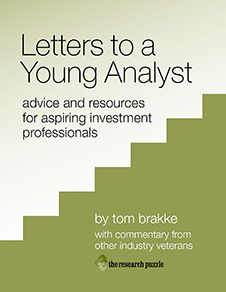
- Tuesday, October 7th, 2014
- training by osmosis
-
As a group, investment professionals are famously independent and resistant to most organizational initiatives almost as a matter of principle. Not coincidentally, investment firms often flounder because of cultural issues that other kinds of organizations try hard to address (sometimes too hard, of course, and not always successfully either).
The frontier spirit at many investment shops is understandable to a certain degree — getting the work done without talking about it incessantly has an appeal to most who find their way into the industry. But an organization isn’t self-organizing; sooner or later some structure is required and some energy needs to be expended to make it work.
Given the bias against any heavy-handedness among the troops, the leader of an investment firm needs to pick his or her spots as to where and how to add that structure. In my experience, training is one area that could use attention in many organizations.
I don’t mean “cultural” training (which, despite being generally feared by investment professionals, can contribute to an organization’s competitive advantage), but vocational training, designed to improve the technical skills of employees.
It seems odd to say that, given that well more than a hundred thousand people sit for one of the CFA exams every year, other investment certification programs also have in-depth bodies of knowledge to master, and lots of MBAs end up in investment roles as well.Letters to a Young Analyst | One of the letters in my book specifically talks about the relative merits of getting a CFA or an MBA, and the book itself addresses the need for continual improvement by those entering the investment business. Nevertheless, I think most firms could do better than they do in training their investment employees.
When you hire an experienced analyst, it’s understandable that the employer basically thinks, “We’re hiring you as an analyst, so be an analyst” — and that the analyst readily agrees. Sure, there are some systems to learn and maybe some firm lingo, but on Day One the analyst goes about the work as she or he did before. No plan for improvement and little possibility of it.
To the extent that improvement comes, it results from brushing up against other analysts and portfolio managers — and learning from them. But the ideas that normally pass among them are investment ones, not methodological ones. There’s not a developmental agenda; you go with the skills you had when you came in the door.
Those with less experience are often working toward earning their credentials. That’s their formal training. Other than that, it’s mostly training by osmosis. In fact, when I ask people in organizations how they are being trained or were trained, the most common answer is, “By osmosis.”
Think about it. If that’s the case, how is the organization going to get better? Sure, if the old hands have a magic formula, it’s good for the new kids on the block to learn it, but should the boundaries be that static?
An example: Due diligence is a critical skill in most every investment endeavor, yet few get any real training in it. During a presentation to a CFA society this summer, I asked how many felt that they had been properly trained in due diligence techniques. One person (out of forty or fifty) raised his hand.
Learning by osmosis is OK as far as it goes, but it doesn’t go far. Training should be planned, thorough, and not limited to the skills already available in house. The goal should be for the organization to get better by having the people get better. That doesn’t happen by chance.
